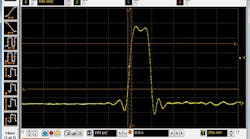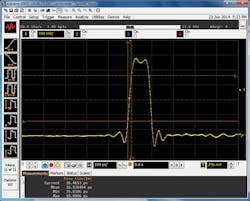This file type includes high resolution graphics and schematics when applicable.
Waveform generation plays a critical part in testing analog and digital circuits and systems, whether for commercial or military applications. The M8195A arbitrary waveform generator from Keysight Technologies is a popular RF/microwave signal generator that featured impressive capabilities when first introduced, including signal generation to 20 GHz. But that wasn’t good enough for the restless engineers at Keysight, who upgraded the performance of this versatile signal source with several new features and frequency-generation capability to 25 GHz.
The latest generation of the M8195A arbitrary waveform generator (AWG) offers up to 65 Gsamples/s on as many as four synchronized channels, all from a one-slot AXIe module (Fig. 1). The AXIe modular format allows for flexibility, adding channels and memory as needed. Each AXIe module can be configured with one, two, or four differential channels; more modules can be added to a chassis when the need arises for more test channels (the number of channels is software-upgradeable). As many as 16 signal channels can be generated from four M8195A AWG modules tucked into a five-slot AXIe chassis.
Programming of the AWG is handled by an AXIe embedded controller or software on an external personal computer (PC). The AWG provides 8-b vertical resolution across an analog bandwidth of 25 GHz, and packs as much as 16 Gsamples of waveform memory per AXIe module. At the fastest sampling rate, this translates into a running time of 250 ms, allowing operators to create long and/or complex signal patterns with the AWG’s sequencer option.
Specs and Other Features
These are high-quality signals, with as much as 1-V peak-to-peak, single-ended amplitude and 2-V peak-to-peak differential amplitude, within a voltage window of –1.0 to +3.3 V. They’re suited for digital as well as analog testing, with an 80%/20% rise/fall time of typically 18 ps with no predistortion and typically 12 ps with predistortion applied (Fig. 2). The intrinsic jitter is less than 200 fs. The M8195A incorporates frequency- and phase-response calibration to maintain the best possible signal quality. Each AWG includes a 16-tap finite-impulse-response (FIR) filter in hardware to execute frequency-response corrections as needed.
Software is modular with the AWG—waveform-generation capabilities can be modified as needed by adding software tools, such as the M8085A software plug-in. It works with the AWG to create a multiple-lane MIPI C-PHY and D-PHY receiver test-application.
For those working on optical communications networks and components, the 81195A optical modulation generator software provides the test signal patterns needed for high-speed optical testing. The software can be equipped with a real-time digital-signal-processing (DSP) option that makes it possible to change signal properties and impairments at runtime or just prior to testing It evaluates the effects of those changes or impairments on system performance.
As noted at its introduction, the M8195A AWG takes on the most complex test waveforms for analog, digital, and optical testing. Now the instrument delivers additional available bandwidth and greater control flexibility. Especially for laboratories and testbenches where space is at a premium, this powerful signal-generation solution can be expanded with new channels and capabilities as needed and/or as budget permits. P&A: $95,000.
Keysight Technologies Inc., 1400 Fountaingrove Pkwy., Santa Rosa, CA 95403; (707) 577-2663
This file type includes high resolution graphics and schematics when applicable.



